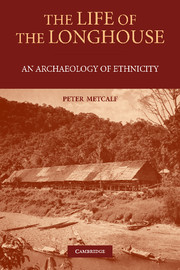Book contents
- Frontmatter
- Contents
- List of Figures
- The Problem: Ethnicity and Community
- PART I LONGHOUSES
- PART II LONGHOUSES AND LEADERS
- PART III LONGHOUSE AND TRADE
- PART IV LONGHOUSE POPULATIONS
- PART V LONGHOUSES AND RITUAL
- PART VI LONGHOUSES AND THE STATE
- Conclusion: The General in the Particular
- Appendix
- Bibliography
- Index of Ethnonyms
- Index of Authors and Subjects
The Problem: Ethnicity and Community
Published online by Cambridge University Press: 25 January 2010
- Frontmatter
- Contents
- List of Figures
- The Problem: Ethnicity and Community
- PART I LONGHOUSES
- PART II LONGHOUSES AND LEADERS
- PART III LONGHOUSE AND TRADE
- PART IV LONGHOUSE POPULATIONS
- PART V LONGHOUSES AND RITUAL
- PART VI LONGHOUSES AND THE STATE
- Conclusion: The General in the Particular
- Appendix
- Bibliography
- Index of Ethnonyms
- Index of Authors and Subjects
Summary
In the nineteenth and twentieth centuries, no one travelled along the fast-flowing rivers that snake toward the mountainous centre of Borneo without remarking on the stupendous buildings that were to be found along their banks. They were massive structures, accommodating hundreds of residents under one high-pitched roof, their floors raised well above ground level on sturdy pilings, their roomy interiors shady and inviting after the tropical brightness outside. To travel at all in the region was to travel between longhouses, and every arrival was a surprise. After hours of seeing nothing along the riverbanks but mangroves and palms and behind them the great trees of the rainforest, the first indication was a clump of canoes drawn up around an impromptu dock made of floating logs. On the bank above was a screen of fruit trees, and behind that the looming bulk of the longhouse. From apparently empty forest, the visitor was abruptly immersed in the social density of a city.
Why Longhouses?
No simple feature of ecology or geography requires this peculiar mode of residence. In other parts of Southeast Asia, populations with similar forest environments and technologies of swidden agriculture live dispersed more evenly across the terrain. Throughout large areas of the Philippines and Indonesia, relatively insubstantial single-family houses are typically sited in small clusters directly adjacent to current farm sites. Indeed, there are obvious advantages to this arrangement, as compared to travelling back and forth between longhouses and jungle farms that have to be cleared anew every year.
Information
- Type
- Chapter
- Information
- The Life of the LonghouseAn Archaeology of Ethnicity, pp. 1 - 28Publisher: Cambridge University PressPrint publication year: 2009
